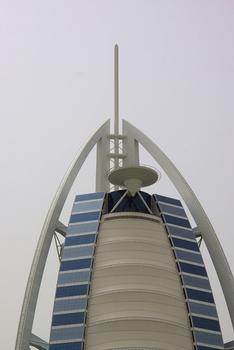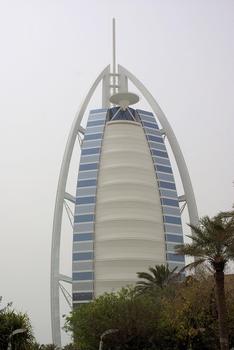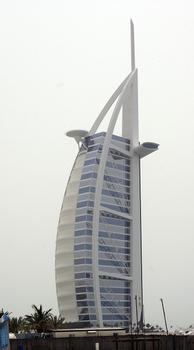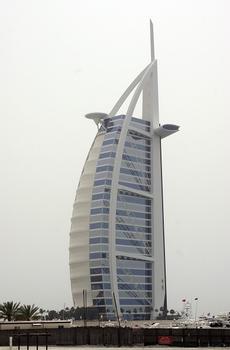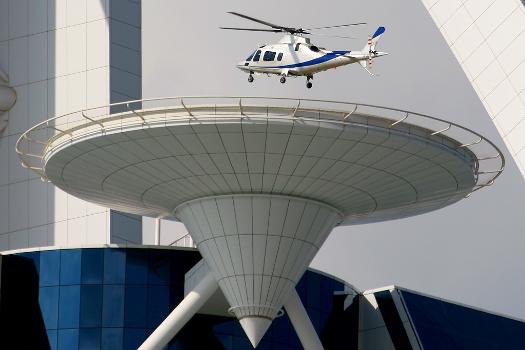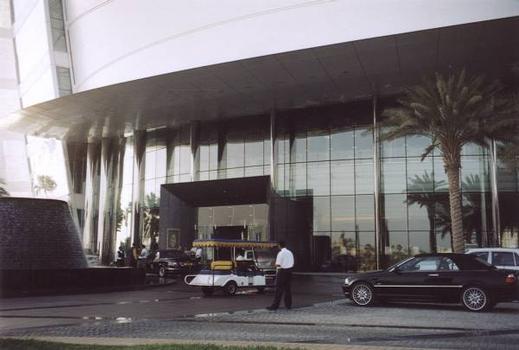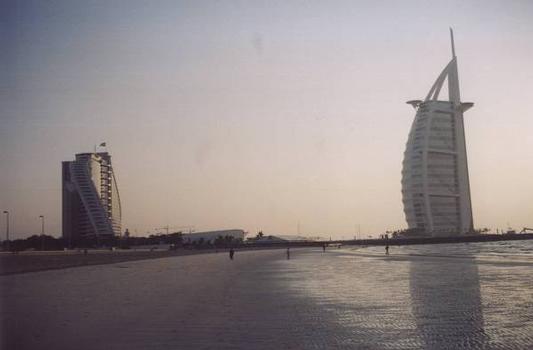General Information
| Name in local language: | برج العرب |
|---|---|
| Other name(s): | Chicago Beach Hotel; Arabian Tower |
| Completion: | 1999 |
| Status: | in use |
Project Type
| Structure: |
Frame |
|---|---|
| Function / usage: |
Hotel |
| Material: |
Reinforced concrete structure Steel structure |
Location
| Location: |
Dubai, Dubai, United Arab Emirates |
|---|---|
| Near: |
Burj Al Arab Access Bridge
|
| Coordinates: | 25° 8' 28.31" N 55° 11' 6.40" E |
Technical Information
Dimensions
| height | 321 m | |
| number of floors (above ground) | 60 |
Cost
| cost of construction | United States dollar 2 000 000 000 |
Materials
| façade |
glass
Teflon-coated fiberglass |
|---|---|
| building structure |
steel
reinforced concrete |
Excerpt from Wikipedia
The Burj Al Arab (Arabic: برج العرب, Tower of the Arabs) is a luxury hotel located in the city of Dubai, United Arab Emirates. Managed by Jumeirah hotel group, it is one of the tallest hotels in the world, although 39% of ist total height is made up of non-occupiable space. Burj Al Arab stands on an artificial island that is 280 m (920 ft) from Jumeirah Beach and is connected to the mainland by a private curving bridge. The shape of the structure is designed to resemble the sail of a ship. It has a helipad near the roof, at a height of 210 m (689 ft) above ground.
Site
The beachfront area where Burj Al Arab and Jumeirah Beach Hotel are located was previously called Chicago Beach. The hotel is located on an island of reclaimed land, 280 m (920 ft) offshore of the beach of the former Chicago Beach Hotel. The locale's name had ist origins in the Chicago Bridge & Iron Company, which at one time welded giant floating oil storage tanks, known locally as Kazzans, on the site.
Design and construction
The Burj Al Arab was designed by the multidisciplinary consultancy Atkins, led by architect Tom Wright. The design and construction were managed by Canadian engineer Rick Gregory, also of WS Atkins. Construction of the island began in 1994 and involved up to 2,000 construction workers during peak construction. It was built to resemble the billowing spinnaker sail of a J-class yacht. Two "wings" spread in a V to form a vast "mast", while the space between them is enclosed in a massive atrium.
The hotel was built by South African construction contractor Murray & Roberts, now renamed Concor and Al Habtoor Engineering. The interior designs were led and created by Khuan Chew and John Coralan of KCA international and delivered by UAE based Depa Group.
The building opened on 1 December 1999.
The hotel's helipad was designed by Irish architect Rebecca Gernon. The helipad is above the building's 59th floor, and has been used as a car race track, a boxing ring, a tennis match, and the jumping off point for the highest kite surfing jump in history.
Features
Several features of the hotel required complex engineering feats to achieve. The hotel rests on an artificial island constructed 280 m (920 ft) offshore. To secure a foundation, the builders drove 230 40-metre-long (130 ft) concrete piles into the sand.
Engineers created a ground surface layer of large rocks, which is circled with a concrete honeycomb pattern, which serves to protect the foundation from erosion. It took three years to reclaim the land from the sea, while it took fewer than three years to construct the building itself. The building contains over 70,000 m³ (92,000 cu yd) of concrete and 9,000 tons of steel.
Inside the building, the atrium is 180 m (590 ft) tall. The 18 storied atrium is enclosed by 12 individually tensioned two-layer membrane panels form the north facing façade.
Given the height of the building, the Burj Al Arab is the world's fifth tallest hotel after Gevora Hotel, JW Marriott Marquis Dubai, Four Seasons Place Kuala Lumpur and Rose and Rayhaan by Rotana. But where buildings with mixed use were stripped off the list, the Burj Al Arab would be the world's third tallest hotel. The structure of the Rose Rayhaan, also in Dubai, is 333 metres (1,093 ft) tall, 12 m (39 ft) taller than the Burj Al Arab, which is 321 metres (1,053 ft) tall.
Rooms and suites
The hotel is managed by the Jumeirah Group. Despite ist size, the Burj Al Arab holds only 28 double-story floors which accommodate 202 bedroom suites. The smallest suite occupies an area of 169 m² (1,820 sq ft), the largest covers 780 m² (8,400 sq ft).
Suites feature design details that juxtapose east and west. White columns show great influence.[ clarification needed] Bathrooms are accented by mosaic tile patterns.
The Royal Suite, billed at US$24,000 per night, is listed at number 12 on World's 15 most expensive hotel suites compiled by CNN Go in 2012.
The Burj Al Arab is very popular with the Chinese market, which made up 25 percent of all bookings at the hotel in 2011 and 2012.
Services
The hotel has a shuttle service with Rolls-Royces and a helicopter, and a private beach.
Restaurants
There are six restaurants in the hotel, including:
- Al Muntaha ("The Ultimate"), is located 200 m (660 ft) above the Persian Gulf, offering a view of Dubai. It is supported by a full cantilever that extends 27 m (89 ft) from either side of the mast, and is accessed by a panoramic elevator.
- Al Mahara ("Oyster"), which is accessed via a simulated submarine voyage, features a large seawater aquarium, holding roughly 990,000 L (260,000 US gal) of water. The wall of the tank, made of acrylic glass in order to withstand the water pressure, is about 18 cm (7.1 in) thick.
Rating
The Burj Al Arab is a five-star hotel, the highest official ranking. While the hotel is sometimes erroneously described as "the world's only 'seven-star' hotel", the hotel management claims never to have done that themselves. The term appeared due to a British journalist who had visited the hotel on a tour before the hotel was officially opened. The journalist described Burj al Arab as "more than anything she has ever seen" and therefore referred to it as a seven-star hotel. In the words of a Jumeirah Group spokesperson: "There's not a lot we can do to stop it. We're not encouraging the use of the term. We've never used it in our advertising."
Reception
Reviews by architecture critics
Burj Al Arab has attracted criticism as well "a contradiction of sorts, considering how well-designed and impressive the construction ultimately proves to be." The contradiction here seems to be related to the hotel's decor. "This extraordinary investment in state-of-the-art construction technology stretches the limits of the ambitious urban imagination in an exercise that is largely due to the power of excessive wealth." Another critic includes negative critiques for the city of Dubai as well: "both the hotel and the city, after all, are monuments to the triumph of money over practicality. Both elevate style over substance." Yet another: "Emulating the quality of palatial interiors, in an expression of wealth for the mainstream, a theater of opulence is created in Burj Al Arab … The result is a baroque effect".
Text imported from Wikipedia article "Burj Al Arab" and modified on December 29, 2021 according to the CC-BY-SA 4.0 International license.
Participants
Relevant Web Sites
Relevant Publications
- (1998): Lifting of the Exoskeleton for the World's Tallest Hotel. In: VSL News, v. 9, n. 1 ( 1998), pp. 12.
- (2008): Skyscrapers. A History of the World's Most Extraordinary Buildings. 2nd edition, Black Dog & Leventhal Publishers, Inc., New York (USA), ISBN 978-1-57912-787-9, pp. 122-123.
- (2000): Vorbote eines neuen Jahrtausends. In: Baukultur, n. 6 ( 2000), pp. 6-8.
- About this
data sheet - Structure-ID
20001194 - Published on:
24/01/2001 - Last updated on:
28/12/2021

.jpg)
